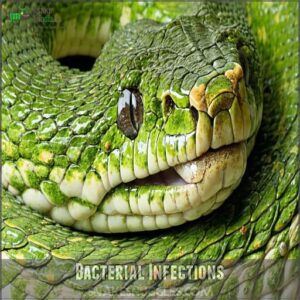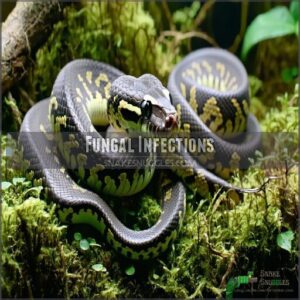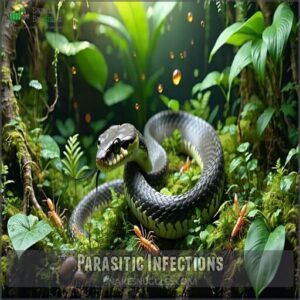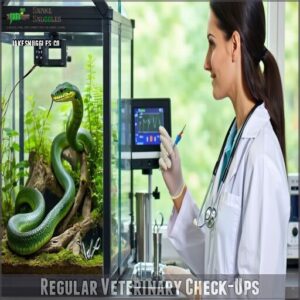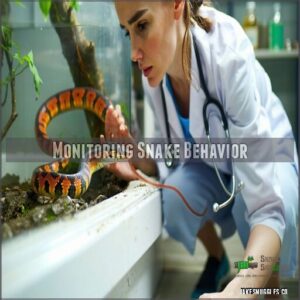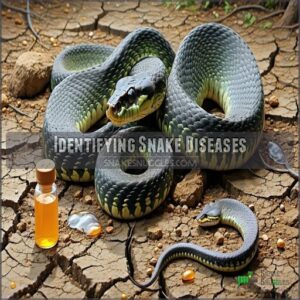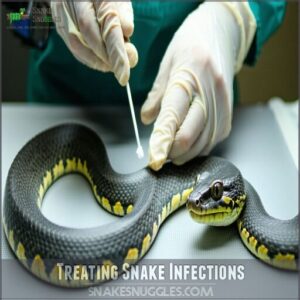This site is supported by our readers. We may earn a commission, at no cost to you, if you purchase through links.
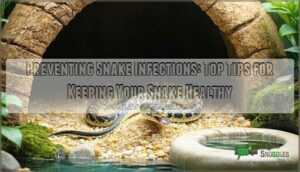
Keep their enclosure clean—no one thrives in a dirty home, not even your snake. Control humidity to avoid fungal issues and guarantee proper ventilation to prevent bacterial growth.
Feed a balanced diet because, let’s face it, a well-fed snake is a healthier one.
Watch for signs of stress or illness, like changes in behavior or appetite—it’s like your snake’s way of waving a tiny red flag. The right setup with hiding spots and temperature control can work wonders for their health, and wanting more is a natural next step to ensure your snake stays healthy.
Table Of Contents
- Key Takeaways
- Snake Infection Causes
- Preventing Snake Infections
- Snake Health Maintenance
- Identifying Snake Diseases
- Treating Snake Infections
- Frequently Asked Questions (FAQs)
- What causes snake infections?
- What is the best way to prevent snake mites?
- How do you reduce your risk of snakebite?
- How to prevent respiratory infections in snakes?
- How do you treat a snake infection?
- What can you do to prevent syphilis?
- How do you prevent snake fungal disease?
- How do I prevent snake bites?
- How to prevent illness in snakes?
- How can snake fungal disease be prevented?
- Conclusion
Key Takeaways
- Keep your snake’s enclosure clean by regularly disinfecting, removing waste, and maintaining proper water quality.
- Control humidity using a hygrometer and ensure proper ventilation to prevent fungal and bacterial growth.
- Provide a balanced diet with appropriate nutrition and hydration to support your snake’s immune system.
- Watch for early signs of illness like behavioral changes, shedding issues, or appetite loss, and consult a vet when necessary.
Snake Infection Causes
Snake infections often stem from bacteria, fungi, parasites, or issues with their environment, like poor hygiene or incorrect humidity.
Understanding these factors helps you spot problems early and keep your snake healthy and happy.
Bacterial Infections
Bacterial infections in snakes, like mouth rot or septicemia, often arise from poor hygiene or stress.
Early detection and a clean, stress-free habitat are the ultimate defenses against bacterial infections like mouth rot or septicemia.
Always keep their environment clean and dry to prevent bacterial growth. Watch for symptoms like swollen gums or lethargy—early detection is key.
Stomatitis treatment may involve antibiotics, but be cautious of antibiotic resistance. A clean, stress-free habitat guarantees your snake stays healthy.
Fungal Infections
Snake fungal disease, caused by Ophidiomyces ophiodiicola, thrives in unclean or damp conditions.
Skin infections from this fungus can lead to lesions and discoloration.
Protect your snake with:
- Fungal Prevention: Keep habitats clean and dry.
- Cleanliness Importance: Sanitize outdoor equipment before use.
- Antifungal Therapy: Treat infections early with specialized care, like antifungal treatment and supportive therapies.
Parasitic Infections
Parasitic infections in snakes, like those caused by internal parasites or mites, can wreak havoc on their health.
Cryptosporidiosis often damages digestion, while external parasites like ticks require swift treatment.
Regular deworming and antiparasitic drugs are lifesavers.
Don’t forget proper mite treatment, tick prevention, and cleaning to keep snake parasites at bay—your slithery friend will thank you!
Fecal examinations are essential for detecting parasite eggs.
Environmental Factors
A clean, well-planned snake environment is essential for preventing infections.
Start with proper substrate choice and maintenance to avoid bacteria buildup. Make sure the enclosure size allows movement while controlling temperature gradients with precision.
Keep water quality exceptional, replacing it regularly, and use proper lighting to mimic natural conditions.
Balanced snake hygiene guarantees effective disease prevention and a thriving snake enclosure, which is achieved by following these proper steps and maintaining exceptional water quality, ultimately leading to effective disease prevention.
Preventing Snake Infections
Keeping your snake infection-free starts with proper care and a clean environment. By managing cage hygiene, humidity, ventilation, and diet, you’ll create a healthy home for your scaly companion.
Proper Cage Hygiene
Maintaining proper snake hygiene starts with substrate selection—choose materials that are easy to clean and replace.
Regularly remove feces to prevent bacterial buildup, and don’t skip weekly disinfecting of enclosures and cage furnishings.
To maintain a healthy habitat, consider using a suitable cage cleaner.
Pay attention to water sanitation, as dirty water can harbor harmful bacteria.
A clean snake environment is key to preventing snake disease and bacterial infections effectively.
Humidity Control
After cleaning your snake’s enclosure, focus on fine-tuning humidity.
Improper humidity levels can lead to shedding problems, respiratory health issues, and even mold growth.
Use a hygrometer for humidity monitoring, keeping it within the ideal range for your species.
Balanced hydration levels also prevent bacterial growth.
Proper snake humidity control supports hydration, enhances shedding, and minimizes the risk of infections.
To find the right one, consider snake hygrometer options.
Ventilation Systems
Good airflow design is key to your snake’s health. It supports the respiratory system, fights bacterial and fungal infections, and even manages odors.
To optimize ventilation, there are several steps you can take.
- Use mesh lids or side vents.
- Prevent mold with frequent airflow.
- Balance humidity to stop respiratory disease.
- Keep air moving with fans.
- Regularly check system maintenance.
Many keepers source ventilation supplies online for their enclosures, which helps in maintaining good airflow.
Balanced Diet
A balanced diet plays a key role in snake health and disease prevention.
Focus on meeting their nutritional needs by offering appropriate prey variety. Don’t overlook the importance of hydration and vitamin supplements to support overall snake nutrition.
Proper snake care avoids obesity while ensuring robust immune function, keeping infections at bay and making your slimy friend thrive with proper care!
Snake Health Maintenance
Keeping your snake healthy starts with regular care and attention to its specific needs, like proper temperature and hiding spaces.
By watching for changes in behavior and scheduling vet visits, you’ll catch problems early and keep your scaly friend thriving.
Regular Veterinary Check-Ups
A yearly vet visit isn’t just a box to check—it’s essential for early detection and preventative care.
A thorough check-up includes parasite screening, a husbandry review, and verifying your snake’s health certificate is spotless.
Veterinary care helps spot issues before they escalate, keeping snake disease prevention and treatment on track, which is crucial for expert reptile care that guarantees your scaly friend thrives.
Regular fecal analysis can help detect internal and external parasites, which is a key part of preventative care and helps in the early detection of potential health issues.
Monitoring Snake Behavior
Noticing changes in your snake’s eating habits, shedding patterns, or activity levels can signal potential snake disease symptoms.
Keep a sharp eye on unusual behavior like reduced social interaction or lethargy—subtle signs often point to emerging issues.
Regular snake health monitoring helps you catch problems early, ensuring better snake conditions monitoring and timely care for a healthier, happier pet, which is crucial for snake health and overall well-being.
Maintaining Thermal Gradient
A proper thermal gradient is critical for your snake’s health.
Set a basking spot with a heat source on one side and a cool zone on the other. Monitor temperatures closely to maintain the gradient’s importance.
Pair this with correct humidity for balanced husbandry. Happy snakes, after all, thrive in a well-planned terrarium.
Small details, big rewards, are a result of understanding the importance of a proper thermal gradient and balanced husbandry.
Providing Hiding Spots
A stressed snake is more prone to infections.
Providing secure hides, sized correctly for your snake, helps with stress reduction and promotes health.
Choose sturdy materials like wood or plastic that can handle frequent enclosure cleaning.
Hides enhance enclosure enrichment, giving your snake a private retreat, which aids in preventing bacterial or fungal issues related to stress or open areas, and supports overall health.
Identifying Snake Diseases
Spotting the signs of illness early can mean the difference between a quick recovery and a severe health crisis for your snake.
By learning to recognize common symptoms like changes in breathing, appetite, or skin condition, you’ll be better equipped to act fast and keep your snake healthy.
Signs of Respiratory Infections
Spotting snake respiratory infections early can save your scaly friend’s life.
Spotting respiratory infections early is a lifesaver—ensure your snake breathes easy and stays happy with prompt care and attention.
Watch for:
- Nasal discharge or mucus buildup.
- Open-mouth breathing, often with wheezing sounds.
- Lethargy signs, like reduced movement or appetite.
- Gurgling noises from the throat or lungs.
These signs suggest a respiratory disease that’s no joke.
Always consult a vet quickly to tackle snake infections head-on!
Symptoms of Skin Infections
Skin infections in snakes, like snake dermatitis, often appear as red, inflamed skin, blister-like lesions, or fluid-filled blisters.
Left untreated, these can lead to scale abnormalities or severe skin damage. Snakes in damp or dirty habitats are most vulnerable.
One common issue is scale rot development, which can be avoided with proper sanitation.
| Symptom | Appearance | Cause | Action |
|---|---|---|---|
| Red inflamed skin | Redness, swelling | Poor hygiene or humidity | Clean and adjust setup |
| Blister-like lesions | Small raised sores | Moisture or bacteria | Seek care immediately |
| Fluid-filled blisters | Pus-filled bumps | Advanced infection | Antibiotics, vet care |
| Scale abnormalities | Peeling or discoloration | Untreated dermatitis | Topical antifungals |
Diagnosing Parasitic Infections
When diagnosing parasites in snakes, look for:
- Fecal Analysis: Detect parasites like Cryptosporidium through stool tests.
- Behavior Changes: Weight loss, anorexia, and abnormal stools can signal infection.
- Mite Identification: Check for black dots and excessive soaking.
- Blood Smears: Spot parasites in blood.
- Snake Veterinary Care: Regular exams aid early parasite control and effective treatment.
Autopsies can reveal internal organ damage.
Recognizing Septicemia
If your snake’s belly turns red or scales show discoloration, it might be septicemia, a deadly condition.
Watch for lethargy signs, appetite loss, and even open-mouth breathing.
These snake bite infection signs often mean bacteria hit their bloodstream.
Acting fast with a vet’s help is essential. Remember, treating snake infections always beats risking their life.
Treating Snake Infections
When your snake shows signs of illness, quick and effective treatment is essential to prevent complications.
From antibiotics to antifungal and deworming medications, knowing when to act can help your pet recover and stay healthy.
Antibiotic Therapy
When treating bacterial infections in snakes, antibiotics need careful handling.
Follow these guidelines to guarantee effective therapy:
- Match the antibiotic: Use medications like ceftazidime or enrofloxacin for common infections.
- Follow dosage guidelines: Always measure precisely, avoiding antibiotic resistance.
- Choose the right method: Inject, gavage, or mix with food.
- Watch for side effects: Monitor for appetite loss or sluggish behavior.
Antifungal Medications
When battling snake fungal disease, antifungal medications like azoles or polyenes can help combat fungal infections.
Topical antifungals work on mild skin infections, while systemic antifungals address severe issues. Nebulization offers a hands-off option for tricky cases.
However, antifungal resistance is a challenge, so early professional intervention is key. Keep your scaly companion’s enclosure clean to minimize fungal diseases.
| Type | Example Medications | Usage | Ideal For | Notes |
|---|---|---|---|---|
| Azole | Itraconazole, Voriconazole | Systemic | Severe infections | Strong but slower-acting |
| Polyene | Amphotericin B | Injectable | Critical cases | Potent, requires monitoring |
| Topical | Clotrimazole | Local application | Skin infections | Easy but limited reach |
| Nebulization | Terbinafine | Inhaled therapy | Respiratory fungal issues | Minimizes handling stress |
| Systemic | Combination therapy | Oral or injectable dosage | Resistant infections | Effective with consistency |
Deworming Medications
Deworming your snake is essential for parasite control. Use the right medication types, like ivermectin, for roundworms and intestinal worms.
Follow these tips for success:
- Calculate dosage based on your snake’s weight.
- Administer orally or via injection as directed.
- Monitor for resistance issues over time.
- Prioritize preventative deworming schedules.
- Consult a vet for regular parasite checks.
Topical Treatments for Skin Infections
A clean routine works wonders!
Use antiseptic solutions for snake sores or blister care, followed by gentle ointment application to heal scale damage.
Skin infections need consistent attention—antibiotics may sometimes be necessary.
To prevent relapse, maintain excellent habitat hygiene.
Spotting snake blisters early and acting swiftly avoids deeper issues.
Healthy scales mean a happier, thriving snake!
Frequently Asked Questions (FAQs)
What causes snake infections?
Snake infections can stem from poor hygiene, dirty enclosures, or stress—kind of like forgetting to clean your room for months.
They’re also caused by bacteria, viruses, parasites, or a weakened immune system from improper care or diet.
What is the best way to prevent snake mites?
To prevent snake mites, regularly inspect your snake and its enclosure, deep-clean everything, and replace bedding often.
Quarantining new snakes and disinfecting tools helps too.
Mites can’t survive if you stay proactive and thorough!
How do you reduce your risk of snakebite?
Stay smart and steer clear of snake strikes: stick to paths, wear boots in brush, and watch where you walk or place hands.
Don’t poke or provoke—it’s not worth the risk.
Stay aware, stay safe.
How to prevent respiratory infections in snakes?
Provide proper humidity levels, make certain good ventilation, and keep their enclosure warm to stave off respiratory issues.
Don’t skip regular cleaning, and always quarantine new snakes to avoid passing any lurking germs.
How do you treat a snake infection?
Did you know up to 90% of snake infections stem from poor care.
Treat infections with vet-prescribed antibiotics, proper hygiene, and environmental cleaning.
Always address symptoms early to stop them from snowballing into bigger problems.
What can you do to prevent syphilis?
You protect yourself from syphilis by using condoms, getting tested regularly, and staying loyal to one sexual partner.
Open, honest conversations with partners about sexual health go a long way—awkward talks are better than unwanted surprises.
How do you prevent snake fungal disease?
Avoid snake fungal disease like the plague by keeping their environment spotless.
Deep clean enclosures regularly, disinfect outdoor gear, make certain proper humidity, and don’t forget—always wash your hands after handling or feeding your scaly friend!
How do I prevent snake bites?
Stay safe by wearing boots and long pants outdoors, especially in snake-prone areas.
Stick to clear paths, avoid tall grass, and don’t poke at snakes.
Keep calm and back away slowly if you spot one, this is a critical moment to keep calm.
How to prevent illness in snakes?
Keep your snake’s enclosure clean, maintain proper humidity, and provide a balanced diet.
Quarantine new arrivals, disinfect equipment, and wash your hands.
Inspect your snake regularly—healthy habits keep their slithery spirits high!
How can snake fungal disease be prevented?
Snake fungal disease doesn’t stand a chance when you maintain spotless enclosures, avoid sharing equipment between snakes, and wash your hands religiously.
Cleanliness is king—disinfect boots, tools, and cages regularly to keep infections away and maintain cleanliness!
Conclusion
Imagine your snake as a tiny scaled adventurer, relying on you to maintain its world.
Preventing snake infections isn’t complicated if you prioritize simple yet essential tasks.
Keep their enclosure clean, balance the humidity, and provide proper ventilation.
Offer a nutritious diet, maintain a stress-free setup, and watch for subtle changes in behavior.
With regular care and attention, your snake can thrive in a healthy environment, ensuring a happy, slither-filled journey together.

